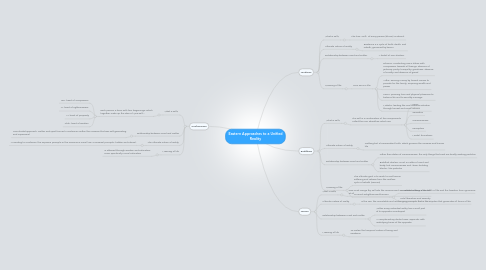
1. Confucianism
1.1. What is self?
1.1.1. Each person is born with four beginnings, which together make up the idea of "pre-self":
1.1.1.1. Jen- heart of compassion
1.1.1.2. Yi- heart of righteousness
1.1.1.3. Li- heart of propriety
1.1.1.4. Chih- heart of wisdom
1.2. Relationship between mind and matter
1.2.1. Non-dualist approach- matter and spirit formed a continuum within the universe that was self-generating and impersonal
1.3. The ultimate nature of reality
1.3.1. According to Confucius, the supreme principle in the universe is moral law, a universal principle, hidden and eternal.
1.4. Meaning of life
1.4.1. Is attained through wisdom and education- more specifically, moral education
2. Hindusim
2.1. What is self?
2.1.1. The true "self" of every person (ātman) is eternal.
2.2. Ultimate nature of reality
2.2.1. Existence is a cycle of birth, death, and rebirth; governed by karma
2.3. Relationship between mind and matter
2.3.1. A belief of non-dualism.
2.4. Meaning of life
2.4.1. Four aims in life:
2.4.1.1. Dharma- conducting one's duties with compassion towards all beings, absence of jealousy, purity, tranquility, goodness, absence of cruelty, and absence of greed
2.4.1.2. Artha- earning money by honest means to provide for the family; acquiring wealth and power
2.4.1.3. Kama- pursuing love and physical pleasures to balance life and to sanctify marriage
2.4.1.4. Moksha- leading the soul towards salvation through honest and moral actions
3. Buddhism
3.1. What is self?
3.1.1. The self is a combination of five components called the Five Skandhas, which are:
3.1.1.1. Form
3.1.1.2. Sensation
3.1.1.3. Consciousness
3.1.1.4. Perception
3.1.1.5. Mental formations
3.2. Ultimate nature of reality
3.2.1. Nothing but a transcendent truth, which governs the universe and human life
3.3. Relationship between mind and matter
3.3.1. Other than states of consciousness, the only things that exist are briefly existing particles
3.3.2. Buddhist dualism is not a matter of mind and body, but consciousness and "basic building blocks" like particles
3.4. Meaning of life
3.4.1. The ultimate goal is to reach to end human suffering and release from the endless cycle of rebirth (Samara)
3.4.2. To reach enlightenment/nirvana
3.4.2.1. An understanding of the truth of life and the freedom from ignorance
3.4.2.2. Total liberation and serenity
4. Taoism
4.1. What is self?
4.1.1. One must merge thy self into the environment as a whole or there is no self at all
4.2. Ultimate nature of reality
4.2.1. Is the Tao, the immutable and unchanging principle that is the impulse that generates all forms of life.
4.3. Relationship between mind and matter
4.3.1. Within every individual entity lies a small part of its opposite counterpart
4.3.2. A complimentary dualist view- separate, with underlying tones of the opposite
4.4. Meaning of life
4.4.1. To realize the temporal nature of being and existence
